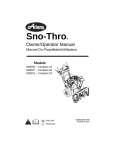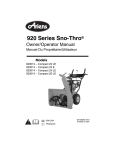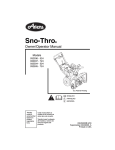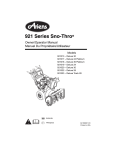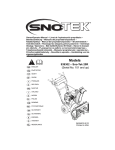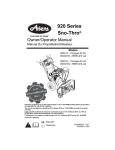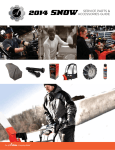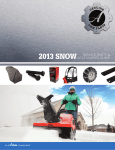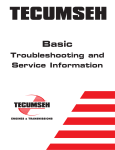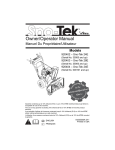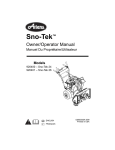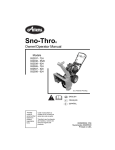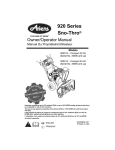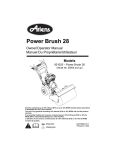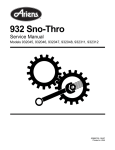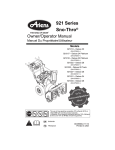Download Ariens 920001- ST624E Snow Blower User Manual
Transcript
Sno-Thro ® Owner/Operator Manual Model 920001 - ST624E ENGLISH FRANÇAIS 01990600 6/07 Printed in USA TABLE OF CONTENTS SAFETY . . . . . . . . . . . . . . . . . . . . . . . . . . . . . . . . . . 3 STORAGE . . . . . . . . . . . . . . . . . . . . . . . . . . . . . . . 23 ASSEMBLY . . . . . . . . . . . . . . . . . . . . . . . . . . . . . . . 7 SERVICE PARTS. . . . . . . . . . . . . . . . . . . . . . . . . . 23 CONTROLS and FEATURES . . . . . . . . . . . . . . . . . 9 ACCESSORIES . . . . . . . . . . . . . . . . . . . . . . . . . . . 23 OPERATION . . . . . . . . . . . . . . . . . . . . . . . . . . . . . 10 TROUBLESHOOTING . . . . . . . . . . . . . . . . . . . . . . 24 MAINTENANCE. . . . . . . . . . . . . . . . . . . . . . . . . . . 14 SPECIFICATIONS . . . . . . . . . . . . . . . . . . . . . . . . . 25 SERVICE AND ADJUSTMENTS . . . . . . . . . . . . . . 16 WARRANTY. . . . . . . . . . . . . . . . . . . . . . . . . . . . . . 34 INTRODUCTION MANUALS Before operation of unit, carefully and completely read your manuals. If used improperly, this unit could be dangerous and cause personal injury or property damage. The contents will provide you with safety instructions for the safe use of your unit during normal operation and maintenance. All reference to left, right, front, or rear are given from operator standing in operation position and facing the direction of forward travel. ENGINE MANUAL The engine on this unit is covered by a separate manual specific to the engine. This manual is included in the literature package that shipped with the unit. Refer to this manual for engine service recommendations. If the engine manual is not available, contact the engine manufacturer for a replacement manual. MODEL AND SERIAL NUMBERS When ordering replacement parts or making service inquiries, know the Model and Serial numbers of your unit and engine. Numbers are located on the product registration form in the unit literature package. They are printed on a serial number label, located on the frame of your unit. Serial Number Label • Record Unit Model and Serial numbers here. • Record Engine Model and Serial number here. PRODUCT REGISTRATION The Ariens dealer must register the product at the time of purchase. Registering the product will help the company process warranty claims or contact you with the latest service information. All claims meeting requirements during the limited warranty period will be honored, whether or not the product registration card is returned. Keep a proof of purchase if you do not register your unit. Customer Note: If the dealer does not register your product, please fill out, sign, and return the product registration card to Ariens or go to www.ariens.com. UNAUTHORIZED REPLACEMENT PARTS Use only Ariens replacement parts. The replacement of any part on this vehicle with anything other than an Ariens authorized replacement part may adversely affect the performance, durability, or safety of this unit and may void the warranty. Ariens disclaims liability for any claims or damages, whether warranty, property damage, personal injury or death arising out of the use of unauthorized replacement parts. To locate your nearest Ariens Dealer, go to www.ariens.com on the internet. DISCLAIMER Ariens reserves the right to discontinue, make changes to, and add improvements upon its products at any time without public notice or obligation. The descriptions and specifications contained in this manual were in effect at printing. Equipment described within this manual may be optional. Some illustrations may not be applicable to your unit. Figure 1 OS8010 GB - 2 © Copyright 2007 Ariens Company DELIVERY WARNING: Improper assembly or adjustments can cause serious injury. Customer Note: If you have purchased this product without complete assembly and instruction by your retailer, it is your responsibility to: 2. Understand all Safety Precautions provided in the manuals. 1. Read and understand all assembly instructions in this manual. If you do not understand or have difficulty following the instructions, contact your nearest Ariens Dealer for assistance. Make sure all assembly has been properly completed. 3. Review control functions and operation of the unit. Do not operate the Sno-Thro unless all controls function as described in this manual. 4. Review recommended lubrication, maintenance and adjustments. NOTE: To locate your nearest Ariens Dealer, go to www.ariens.com on the Internet. 5. Review Limited Warranty Policy. 6. Fill out a Product Registration Card and return the card to the Ariens Company or go to www.ariens.com. SAFETY NOTATIONS NOTE: General reference information for proper operation and maintenance practices. WARNING: To avoid injury to hands and feet, always disengage clutches, shut off engine, and wait for all movement to stop before unclogging or working on snow thrower. IMPORTANT: Specific procedures or information required to prevent damage to unit or attachment. Hand contact with the rotating impeller is the most common cause of injury associated with snow throwers. Never use your hand to clean out the discharge chute. PRACTICES AND LAWS Practice usual and customary safe working precautions, for the benefit of yourself and others. Understand and follow all safety messages. Be alert to unsafe conditions and the possibility of minor, moderate, or serious injury or death. Learn applicable rules and laws in your area. Always follow the practices set forth in this manual. Keep hands and feet away from auger and impeller. SAFETY ALERTS Look for these symbols to point out important safety precautions. They mean: REQUIRED OPERATOR TRAINING Original purchaser of this unit was instructed by the seller on safe and proper operation. If unit is to be used by someone other than original purchaser; loaned, rented or sold, ALWAYS provide this manual and any needed safety training before operation. Attention! Personal Safety Is Involved! Become Alert! Obey The Message! The safety alert symbols above and signal words below are used on decals and in this manual. Read and understand all safety messages. DANGER: IMMINENTLY HAZARDOUS SITUATION! If not avoided, WILL RESULT in death or serious injury. WARNING: POTENTIALLY HAZARDOUS SITUATION! If not avoided, COULD RESULT in death or serious injury. CAUTION: POTENTIALLY HAZARDOUS SITUATION! If not avoided, MAY RESULT in minor or moderate injury. It may also be used to alert against unsafe practices. GB - 3 SAFETY DECALS AND LOCATIONS 2. DANGER! ALWAYS replace missing or damaged Safety Decals. Refer to figures below for Safety Decal locations. 2 OS6610 1 ROTATING PARTS! ONLY use clean-out tool to clear blockages. NEVER use your hands. High speed impeller rotates below discharge opening. Wait for all moving parts to stop before removing clogs or servicing. 3. DANGER! 3 ROTATING PARTS. Keep clear of auger while engine is running. OS2080 Figure 2 • Read Operator’s Manual. • Allow operation only by properly trained adult, never children. • Stop engine and remove ignition key prior to leaving the operator’s position for any reason. • Keep all controls, guards and safety devices properly serviced and functional. • Never direct discharge towards persons or property that may be injured or damaged by thrown objects. OS8015 1. WARNING! Read Owner/Operator Manual. OL1801 OL4370 Keep people away from unit while operating. Keep children out of work area and under watchful care of a responsible adult. SAFETY RULES Never direct discharge towards persons or property that may be injured or damaged by thrown objects. ALWAYS remove key and/or wire from spark plug before assembly, maintenance or service. Unintentional engine start up can cause death or serious injury. OL0910 Stop engine, remove key, read manual before making any repairs or adjustments. OL4010 Wear appropriate hearing protection. Read, understand, and follow all safety practices in Owner/Operator Manual before beginning assembly or operating. Failure to follow instructions could result in personal injury and/or damage to unit. Complete a walk around inspection of unit and work area to understand: • Work area • Your unit • All safety decals ALWAYS check overhead and side clearances carefully before operation. ALWAYS be aware of traffic when operating along streets or curbs. Keep children and people away. Keep children out of work area and under watchful care of a responsible adult. OL4690 ONLY use clean-out tool to clear blockages. NEVER use your hands. NEVER allow children to operate or play on or near unit. Be alert and shut off unit if children enter area. DO NOT allow adults to operate unit without proper training. Only trained adults may operate unit. Training includes actual operation. Keep area of operation clear of all toys, pets, and debris. Thrown objects can cause injury. GB - 4 Check for weak spots on docks, ramps or floors. Avoid uneven work areas and rough terrain. Stay alert for hidden hazards. ROTATING IMPELLER CAN CAUSE SERIOUS INJURY. NEVER ATTEMPT TO UNCLOG OR CLEAN UNIT WHILE ENGINE IS RUNNING. DO NOT operate near drop-offs, ditches, or embankments. Unit can suddenly turn over if a wheel is over the edge of a cliff or ditch, or if an edge caves in. Read, understand, and follow all instructions in the manual and on the machine before starting. Falling snow, fog, etc. can reduce vision and cause an accident. Operate unit only when there is good visibility and light. How to operate all controls. NEVER operate unit after or during the use of medication, drugs or alcohol. Safe operation requires your complete and unimpaired attention at all times. Understand: The functions of all controls. How to STOP in an emergency. Before starting engine, disengage control(s). NEVER allow anyone to operate this unit when their alertness or coordination is impaired. DO NOT operate unit without wearing adequate winter outer garments. Wear adequate safety gear, including safety glasses with side shields, and protective gloves. Wear proper footwear to improve footing on slippery surfaces. DO NOT wear loose clothing or jewelry and tie back hair that may get caught in rotating parts. Protect eyes, face and head from objects that may be thrown from unit. Wear appropriate hearing protection. Avoid sharp edges. Sharp edges can cut. Moving parts can cut off fingers or a hand. ALWAYS keep hands and feet away from all rotating parts during operation. Rotating parts can cut off body parts. Use only approved extension cords and receptacles when starting units equipped with electric starter. DO NOT connect electric starter cord to any wiring system that is not a three-wire grounded system. ALWAYS allow unit and engine to adjust to outdoor temperatures before clearing snow. Always be sure of your footing, especially when operating in reverse or leaving the operator’s position. Walk, never run during operation. DO NOT overload the machine capacity by attempting to operate or to clear snow at too fast a rate. Slow down and turn corners slowly. Do not operate in reverse unless absolutely necessary. ALWAYS back up slowly. Always look down and behind before and while backing. Disengage attachment drive when traveling from one work area to another. Abnormal Vibrations are a warning of trouble. Striking a foreign object can damage unit. Immediately stop unit and engine. Remove key and wait for all moving parts to stop. Remove wire from spark plug. Inspect unit and make any necessary repairs before restart. NEVER place your hands or any part of your body or clothing inside or near any moving part while unit is running. ALWAYS keep hands away from all pinch points. DO NOT touch unit parts which might be hot from operation. Allow parts to cool before attempting to maintain, adjust or service. Never direct discharge towards persons or property that may be injured or damaged by thrown objects. Use extreme caution on gravel surfaces. Stay alert for hidden hazards or traffic. Adjust Runners so Scraper Blade does not contact gravel. DO NOT throw snow any higher than necessary. Deflected materials can cause injury and property damage. Before cleaning, removing clogs or making any inspections, repairs, etc.: disengage clutch(es), stop unit and engine, remove key, allow moving parts to stop. Allow hot parts to cool. Run unit a few minutes after clearing snow to prevent freeze-up of attachment. Disengage attachment when not in use. Disengage all clutches before starting engine. Adjust runners to clear gravel or crushed rock surfaces safely. Never leave a running unit unattended. ALWAYS shut off engine before leaving unit. ALWAYS remove key to prevent unauthorized use. Always stand clear of the discharge area when operating this unit. Fumes from engine exhaust can cause injury or death. DO NOT run engine in an enclosed area. Always provide good ventilation. ALWAYS disengage attachment, stop unit and engine, remove key and allow moving parts to stop before leaving operator’s position. Never carry passengers. Check clutch and brake operation frequently. Adjust and service as required. All motion of drive wheels and auger/impeller must stop quickly when control levers are released. GB - 5 DO NOT operate on steep slopes. DO NOT clear snow across the face of slopes. Keep all movement on slopes slow and gradual. DO NOT make sudden changes in speed or direction. Use a slow speed to avoid stops or shifts on slopes. Avoid starting or stopping on a slope. DO NOT park unit on a slope unless absolutely necessary. When parking on a slope always block the wheels. ALWAYS shut off engine, remove key, and close fuel shut-off valve or drain fuel when transporting unit on a truck or trailer. Use extra care when loading or unloading unit onto trailer or truck. DO NOT change engine governor settings or over-speed engine. Fumes from engine exhaust can cause injury or death. DO NOT run engine in an enclosed area. Always provide good ventilation. ALWAYS maintain unit in safe operating condition. Damaged or worn out muffler can cause fire or explosion. Keep all hardware properly tightened. Check shear bolts frequently. Maintain or replace safety and instruction labels, as necessary. DO NOT transport machine while engine is running. NEVER store unit with fuel in fuel tank, inside a building where any ignition sources are present such as hot water heaters, space heaters, or clothes dryers. Allow the engine to cool before storing in any enclosure. Keep unit free of ice or other debris. Clean up oil or fuel spills. Shut off fuel and allow engine to cool completely before storing in closed area or covering unit. This product is equipped with an internal combustion type engine. DO NOT use unit on or near any unimproved, forest-covered or brush covered land unless exhaust system is equipped with a spark arrester meeting applicable local, state or federal laws. A spark arrester, if it is used, must be maintained in effective working order by operator. For extended storage, clean unit thoroughly. See Engine Manual for proper storage. Secure unit chassis to transport vehicle. NEVER secure from rods or linkages that could be damaged. Use only attachments or accessories designed for your unit. Check components frequently. If worn or damaged, replace with manufacturer’s recommended parts. Fuel is highly flammable and its vapors are explosive. Handle with care. Use an approved fuel container. NO smoking, NO sparks, NO flames. ALWAYS allow engine to cool before servicing. NEVER fill fuel tank when engine is running or hot from operation. NEVER fill or drain fuel tank indoors. Replace fuel cap securely and clean up spilled fuel. Never fill containers inside a vehicle or on a truck or trailer bed with a plastic liner. Always place containers on the ground away from your vehicle before filling. When practical, remove gas-powered equipment from the truck or trailer and refuel it on the ground. If this is not possible, then refuel such equipment on a trailer with a portable container, rather than from a gasoline dispenser nozzle. Keep the nozzle in contact with the rim of the fuel tank or container opening at all times until fueling is complete. Do not use a nozzle lock-open device. If fuel is spilled on clothing, change clothing immediately. Before tipping unit up onto housing, remove fuel so no spills will occur. Ensure unit is secure and will not tip over during maintenance. ALWAYS keep protective structures, guards, and panels in good repair, in place and securely fastened. NEVER modify or remove safety devices. GB - 6 ASSEMBLY . 1 WARNING: AVOID INJURY. Read and understand the entire Safety section before proceeding. 2 WARNING: Dropping or tipping over boxed unit could result in personal injury or damage to unit. 3 PACKAGE CONTENTS 3 2 1. Shift Rod 2. Wing Knob and Bolt 3. Wing Nut and Bolt 4. Handlebar 4 4 Figure 4 1 OS8025 Install Discharge Chute (Figure 5) 1. Grease underside of discharge chute ring (if not already greased). 2. Remove mounting hardware from the bottom of the chute pedestal. 3. Install discharge chute over opening in the auger housing and secure pedestal to auger housing with hardware removed in step 2. OS8020 1. Sno-Thro Unit 2. Discharge Chute 3. Chute Rod 4. Literature Pack with Extra Shear Bolts Figure 3 1 ASSEMBLY Tools Required: • Pliers • Open-End Wrenches: 3/8, 7/16, 1/2, 9/16 in. and/or Adjustable Wrench • Tire Gauge 2 3 1 4 Unfold Handlebar (Figure 4) 1. Remove the lower and loosen the upper wing knobs on the handlebar assembly. 1. Mounting Hardware 2. Discharge Chute 3. Discharge Chute Ring 4. Chute Pedestal 2. Loosen the wing nuts on the shift rod. 3. Put the speed selector lever in the sixth forward position. OS8030 Figure 5 4. Rotate the handlebars into operating position. 5. Install and tighten all wing knobs and wing nuts on the handlebar assembly and shift rod. Install Discharge Chute Crank 1. Slide Chute Crank through the nylon bushing in the support bracket. GB - 7 2. Connect the chute crank to the pinion gear on chute with spring clip pin. Check Auger Gearcase Oil Check oil level in auger gearcase (see Check Auger Gearcase on page 15). Check Engine Crankcase Oil IMPORTANT: The engine is shipped with 5W-30 oil in crankcase. Refer to Engine Manual for detailed instructions. 1 Fill Engine Fuel Tank Refer to Engine Manual for proper fuel type and tank capacity. Check Function of all Controls 2 Ensure unit runs and performs properly. Refer to Operation. Run-in Attachment Belt 3 1. Start unit in a well-ventilated area according to Starting and Shut Off on page 13. 4 2. Engage attachment clutch lever and run attachment for about 15 minutes. 3. Stop unit, wait for all moving parts to stop, and remove spark plug wire. 1. Chute Crank 2. Support Bracket 3. Pinion Gear 4. Spring Clip Pin 4. Adjust belt finger, if necessary. See Attachment Drive Belt Replacement on page 17. Figure 6 5. Adjust clutch idler according to Attachment Drive Belt Replacement on page 17. OS8025 Check Function of Dual Handle Interlock Without the engine running, press down (engage) both clutch levers. Release attachment clutch lever. Attachment clutch should remain engaged until traction clutch lever is released, then both clutches must disengage. If they do not, contact your Dealer for repairs. Check Tire Pressure Check tire pressure and adjust to the pressure listed on tire sidewall. CAUTION: Avoid injury! Explosive separation of tire and rim parts is possible when they are serviced incorrectly: • Do not attempt to mount a tire without the proper equipment and experience to perform the job. • Do not inflate the tires above the recommended pressure. • Do not weld or heat a wheel and tire assembly. Heat can cause an increase in air pressure resulting in an explosion. Welding can structurally weaken or deform the wheel. • Do not stand in front or over the tire assembly when inflating. Use a clip-on chuck and extension hose long enough to allow you to stand to one side. GB - 8 CONTROLS AND FEATURES 1. Attachment Clutch Lever 3 2. Speed Selector 3. Traction Drive Clutch Lever 2 1 4. Chute Crank 5. Muffler Guard 4 6. Discharge Chute Deflector 7. Discharge Chute 5 8. Impeller 9. Auger 26 10. Scraper Blade 6 11. Auger Gearcase 14 13 7 12. Clean-out Tool 12 13. Oil Fill and Dipstick 14. Gas Tank and Cap 8 24 15. Starter Button 16. Electric Starter 17. Recoil Starter Handle 18. Primer Bulb 22 19. Throttle (Engine Stop) 9 11 23 10 20. Ignition Switch (Push /Pull) 21. Choke 22. Axle Lock Pin 18 23. Runner(s) 24. Belt Cover 25. Fuel Shut-off Valve 26. Handlebar 17 19 21 20 15 16 25 Figure 7 OS7077 GB - 9 OPERATION Ignition Switch (Push/Pull Safety Key) WARNING: AVOID INJURY. Read and understand the entire Safety section before proceeding. Key Switch has two positions: 1. “Stop” - pulled out WARNING: To avoid injury to hands and feet, always disengage clutches, shut off engine, and wait for all movement to stop before unclogging or working on snow thrower. Keep hands and feet away from auger and impeller. 2. "Run" - pushed in 2 NOTE: DO NOT twist key after it is inserted. 1 Primer Bulb Pushing the primer bulb in adds fuel for easier engine start. Refer to Starting and Shut Off on page 13. CONTROLS AND FEATURES See Figure 7 for all Controls and Features locations. Dual Handle Interlock OS1321 When Attachment Clutch and then Traction Drive Clutch are engaged, the Attachment Clutch will remain engaged (lever down) if released. To stop attachment, release Traction Drive Clutch and both clutches will disengage. Speed Selector Position the Speed Selector in the appropriate speed notch to control forward and reverse travel. Traction Drive Clutch - Left Hand Lever Squeeze the Traction Drive Clutch Lever against the Handlebar (1) to engage wheel drive for propelling unit. Forward speed will vary according to snow depth and moisture content. 2 1 OL2701 6 1 2 OS1193 Forward: (6) Fastest Release lever (2) to stop movement. NOTE: When traveling to or from the area to be cleared, press down on the handlebars enough to raise the front of the unit slightly off the surface. Engage the traction drive clutch without engaging the attachment drive clutch. Attachment Clutch - Right Hand Lever 2 1 Squeeze Attachment Clutch Lever against handlebar (1) to engage attachment. Release both clutch levers (2) to disengage power and apply brake to attachment. (1) Slowest Reverse: (1) Slow (2) Fast IMPORTANT: DO NOT change motion from forward to reverse with clutch engaged. Forward speed can be changed without declutching. Choke Control Knob 1 IMPORTANT: If the belt squeals when the attachment clutch lever is OL2691 engaged, the impeller may be frozen in the auger housing. Immediately release the attachment clutch lever and move the unit into a heated area to thaw. NOTE: If belt squeals when impeller turns freely, see Attachment Drive Belt Replacement on page 17. GB - 10 2 1 1.Choke Closed position: chokes off air to engine for easier start. 2.Choke Open position: allows for normal operation. IMPORTANT: Gradually open choke after engine starts. Push deflector handle forward or down to throw snow lower. Pull deflector handle up or to the rear to throw snow higher. Throttle 1 The throttle controls the engine speed. To increase or decrease the engine speed, adjust to: 2 1. Fast (normal or warm starts) 3 4 2. Part-Throttle IMPORTANT: If Chute Deflector does not stay in set position, adjust as directed in SERVICE AND ADJUSTMENTS on page 16, or repair before operation. 3. Slow (cold weather starts) Discharge Chute 4. Stop (engine is off) Discharge chute rotates 186°. ALWAYS position discharge chute in safe direction and angle, away from operator and bystanders, before starting engine. Electric Starter The electric starter will start a properly choked and cranked engine when the starter button is pushed. Refer to Starting and Shut Off on page 13. Discharge Chute Crank IMPORTANT: If chute does not stay in set position, adjust as directed in SERVICE AND ADJUSTMENTS on page 16, or repair before operation. Recoil Starter Handle When pulled, handle will turn engine over. IMPORTANT: DO NOT let handle snap back against starter. Rotate the chute with the discharge chute crank handle. See Starting and Shut Off on page 13. IMPORTANT: DO NOT force frozen chute controls. If frozen, take to warm place until controls are free. Snow Clean-Out Tool (Figure 8) Axle Lock Pin (Figure 9) WARNING: Hand contact with the rotating impeller is the most common cause of injury associated with snow throwers. Never use your hand to clean out the discharge chute. Use the axle lock pin to lock or unlock the right or left wheel. Lock both wheels to increase traction; unlock one wheel to allow for easier turning of the unit. NOTE: Unit will not drive with both wheels unlocked. 1 Wheel Unlocked 1. Snow Clean-Out Tool Figure 8 OS8040 Axle Lock Pin To clear the discharge chute: 1. Shut off the engine. Wheel Locked 2. Wait 10 seconds and make sure impeller blades have stopped rotating. 3. Remove the snow clean-out tool (1) from the auger housing and use it to remove the clog from the discharge chute. 4. Replace the snow clean-out tool on the auger housing. Figure 9 Discharge Chute Deflector ALWAYS position discharge chute deflector at a safe angle before starting engine. DO NOT throw snow any higher than necessary. GB - 11 5. Fill fuel tank to within 1/2 in. (1.2 cm) below bottom of filler neck with unleaded gasoline. Scraper Blade The scraper blade allows the back of the housing to keep better contact with the surface being cleared. It also prevents damage to the housing from normal wear. NOTE: Tank capacity is 3.5 qt (3.3 L) 6. Replace Fuel Cap and tighten. 7. ALWAYS clean up any spilled fuel. IMPORTANT: DO NOT allow Scraper Blade to wear too far or Auger/Impeller housing will become damaged. PRE-START 1. Frozen Impeller Runners The runners control the distance between the scraper blade and the ground. Adjust runners equally to keep blade level with the ground. Refer to Pre-Start on page 12 for recommended settings. IMPORTANT: Before starting engine, check impeller to be sure it is not frozen. To check impeller: 1. With ignition key switch in “Stop” position, squeeze Attachment Clutch Lever to Engaged position. FILLING FUEL TANK 2. Pull Recoil Starter Handle. 3. If Impeller is frozen, (cannot pull Starter Handle) move unit to a heated area and thaw to prevent possible damage. WARNING: AVOID INJURY. Read and understand the entire Safety section before proceeding. Fuel Shut-Off Valve 2. Check Function of Clutches IMPORTANT: The fuel shut-off valve MUST be in the closed position prior to transporting the unit. If clutches do not engage or disengage properly, adjust or repair before operation. See Attachment Clutch/Brake Adjustment on page 19 and Traction Drive Clutch Adjustment on page 21 The fuel shut-off valve has two positions: 3. Check Dual Handle Interlock Without the engine running, press down (engage) both clutch levers. Release attachment clutch lever. Attachment clutch should remain engaged until traction clutch lever is released, then both clutches must disengage. Closed Position: Use this position to service, transport, or store the unit. If clutches do not engage or disengage properly, adjust or repair before operation (see Attachment Clutch/Brake Adjustment on page 19 and Traction Drive Clutch Adjustment on page 21). Open Position: Use this position to run the unit. Figure 10 4. Check Axle Lock Use the axle lock pins to lock or unlock the wheels. Lock both wheels to increase traction; unlock one wheel to allow for easier turning of the unit. 5. Check Runners OS7117 Check and adjust Runners (Runners on page 16). Allow 1/8 in. (3 mm) between scraper blade and hard, smooth surface(s). Allow 1-1/4 in. (30 mm) between scraper blade and uneven or gravel surfaces. To add fuel to fuel tank: 1. ALWAYS place unit in open or well-ventilated area. 6. Check Engine Fuel & Crankcase Oil 2. Stop engine and allow to cool. 3. Clean Fuel Cap and surrounding area to prevent dirt from entering Fuel Tank. WARNING: AVOID INJURY. Read and understand the entire Safety section before proceeding. 4. Remove Cap. IMPORTANT: DO NOT use gasohol or gasoline containing alcohol. See Engine Manual for correct type and grade of fuel. Check and add fuel if required. Check that the engine crankcase oil is full using dipstick. Refer to Engine Manual for detailed instructions. GB - 12 TO STOP IN AN EMERGENCY 2. Plug extension cord into 120V 3-wire, grounded outlet. Immediately release both control levers to stop unit in an emergency. Stop engine, remove key and wait for all rotating parts to stop before leaving operator’s position. 3. Turn discharge chute straight ahead. 4. Make sure that the traction clutch and attachment drive clutch levers are fully disengaged. 5. Push Primer Bulb 2 or 3 times for cold engine. STARTING AND SHUT OFF NOTE: When temperature is below -15° F (-26° C) additional priming may be needed. WARNING: FAILURE TO FOLLOW INSTRUCTIONS could result in personal injury and/or damage to unit. DO NOT attempt to start your unit at this time. Read entire Owner/Operator Manual and the Engine Manual first. 6. Insert key into ignition switch on engine and push into "Run" position. DO NOT twist key after it is inserted. 7. If engine is cold, apply choke. A warm engine requires less choking than a cold engine. See Engine Manual for detailed instructions. IMPORTANT: Allow unit and engine to adjust to the outdoor temperature before clearing snow. Before shut-off, run the attachment a few minutes to prevent impeller freeze-up. 8. Set throttle to proper starting position 9. Press starter button on engine until engine starts. NOTE: Try out each control without the engine running to see how it works and what it does. Manual Start IMPORTANT: DO NOT operate starter more than 15 seconds per minute, as overheating and damage can occur. (If engine does not start, refer to TROUBLESHOOTING on page 24.) 10. Adjust choke as needed. 1. Turn discharge chute straight ahead. 2. Make sure that the traction clutch and attachment drive clutch levers are fully disengaged. 3. Push Primer Bulb 2 or 3 times for cold engine. NOTE: When temperature is below -15° F (-26° C) additional priming may be needed. 11. Disconnect power cord from outlet, then starter. 12. Set throttle to Part Throttle or Slow position for adaptation to outside temperature or travel. Set throttle to Fast position for normal operation. Shut Off 4. If engine is cold, apply choke. See Engine Manual for detailed instructions. 1. Release Traction Drive Clutch Lever and allow unit to come to a complete stop. NOTE: A warm engine requires less choking than a cold engine. 2. Run Impeller a few minutes after use to prevent freeze-up of Impeller. 3. Release Attachment Clutch Lever and wait for all moving parts to come to a complete stop. 5. Set throttle to proper starting position. 6. Insert key into ignition switch and push into RUN position. DO NOT twist key after it is inserted. 7. Grasp starter handle and pull rope out slowly until it pulls harder. Let rope rewind slowly. 8. Pull rope with a rapid continuous full arm stroke. Let rope rewind slowly. IMPORTANT: DO NOT let Starter Handle snap against Starter. 9. Repeat steps 7 and 8 until engine starts. (If engine does not start, refer to TROUBLESHOOTING on page 24.) 4. Move Throttle to the “Stop” position 5. Remove key. SNOW REMOVAL IMPORTANT: Allow unit and engine to adjust to the outdoor temperature before clearing snow. NOTE: Attachment clutch should be engaged before wheel drive clutch when throwing snow. 1. Select Speed Control position and direction. 2. Engage Attachment Clutch - Right Hand Lever. 3. Engage Traction Drive Clutch - Left Hand Lever. 10. Adjust choke as needed. IMPORTANT: DO NOT overload unit capacity by attempting to clear snow at too fast a rate. Use slow speed to clear deep or hard packed snow. 11. Set throttle to Part Throttle or Slow position for adaptation to outside temperature or travel. Set throttle to Fast position for normal operation. Tips for Operation Electric Start (120V) 1. Connect extension cord to starter. IMPORTANT: Prevent damage to unit. Know voltage of your starter and only use matching outlets. Snow is best removed as soon as possible after snow fall. GB - 13 3. Engage wheel drive clutch without engaging attachment drive clutch. To clear an area, run unit in an overlapping series of paths. For large areas, start in the middle and throw snow to each side, so snow is not cleared more than once. TRANSPORT ALWAYS direct snow away from area to be cleared and with direction of the wind. TRAVELING ALWAYS shut off engine, remove key, and close fuel shut-off valve when transporting unit on a truck or trailer. Use extra care when loading or unloading unit onto trailer or truck. To travel from one work area to another: 1. Set Throttle to Slow or Part-Throttle position. 2. Press down on handlebars enough to raise front of unit slightly off surface. Secure unit chassis to transport vehicle. NEVER secure from rods or linkages that could be damaged. DO NOT transport machine while engine is running. MAINTENANCE Ariens Dealers will provide any service or adjustments which may be required to keep your unit operating at peak efficiency. Should engine service be required, contact an Ariens dealer or an authorized engine manufacturer's service center. The chart below shows the recommended maintenance schedule that should be performed on a regular basis. More frequent service may be required. MAINTENANCE SCHEDULE WARNING: AVOID INJURY. Read and understand the entire Safety section before proceeding. SERVICE POSITION WARNING: Before tipping unit up onto housing, remove fuel so no spills will occur. Ensure unit is secure and will not tip over during maintenance. Service Performed Each Use Check Dual Handle Interlock • Check Fasteners • Check Clutch Operation • Check Clutch Spring Adjustments Place unit on a flat level surface. Tip unit forward onto front of auger housing for service. Ensure unit is secure and will not tip over. Strap and clamp onto bench if needed. Service Position MAINTENANCE SCHEDULE Clean Engine Every 5 hrs. Every 25 hrs. * • Yearly • Check Engine Oil Change Engine Oil • ** • Check Tire Pressure • Check Auger Gearcase • • General Lubrication • • * After first five hours of operation. ** After first two hours of operation. CHECK DUAL HANDLE INTERLOCK Without the engine running, press down (engage) both clutch levers. Release attachment clutch lever. Attachment clutch should remain engaged until traction clutch lever is released, then both clutches must disengage. CHECK FASTENERS Make sure all hardware is tightened properly. CHECK CLUTCH OPERATION Auger / impeller must stop within 5 seconds when attachment clutch/impeller brake lever is released. Figure 11 OS8045 GB - 14 Wheels must stop quickly when traction drive clutch lever is released. 1 If clutches do not engage or disengage properly, adjust or repair before operation (see Attachment Clutch/Brake Adjustment on page 19 and Traction Drive Clutch Adjustment on page 21). 2 CHECK CLUTCH SPRING ADJUSTMENT Make sure the attachment clutch and traction drive clutch are adjusted to the range specified in Attachment Clutch/Brake Adjustment on page 19 andTraction Drive Clutch Adjustment on page 21. 1. Auger Gearcase 2. Filler Plug Figure 12 OS1870 GENERAL LUBRICATION CLEAN ENGINE IMPORTANT: Wipe each fitting clean before and after lubrication. Do not wipe gearcase filler plug; wiping the gearcase filler plug may remove thread sealant and cause leaks. Refer to Engine Manual for detailed instructions. CHECK ENGINE OIL The engine crankcase oil should be checked every 5 hours of operation. Oil level MUST be maintained in safe operating range on dipstick at all times or engine damage will result (See Engine Manual). Park unit on a level surface. Refer to Engine Manual for detailed instructions. CHANGE ENGINE OIL IMPORTANT: DO NOT allow grease or oil to get on friction disc, friction plate or belts. NOTE: Apply Ariens Hi-Temp Grease or equivalent to the lubrication fittings. See SERVICE PARTS on page 23. Sno-Thro should be lubricated (Figure 13) at beginning of season or every 25 operating hours. Auger Shaft Change oil after first 2 hours of operation, thereafter change oil every 25 hours (more often if required). Refer to Engine Manual for detailed instructions. Run engine just prior to changing oil. Warm oil will flow more freely and carry away more contamination. Remove the oil drain plug from the rear of the unit and tip the unit back to help drain all the oil. NOTE: To grease auger shaft, remove shear bolt nuts, and shear bolts. Apply grease at the grease zerks and then turn the auger assemblies on the auger shaft. Replace shear bolts per instructions in Shear Bolts on page 16. CHECK TIRE PRESSURE Keep tires at pressure listed on the tire sidewall. (see Check Tire Pressure on page 8). CHECK AUGER GEARCASE IMPORTANT: Proper oil level must be maintained. Gear cases are filled to the correct level at the factory. Unless there is evidence of leakage, no additional lubricant should be required. Check oil level each season or every 25 hours of operation. Grease To ensure adequate lubricant level: 1. Remove filler plug (Figure 12). Lubricant must be at least up to bottom of lubricant filler hole with unit resting on a level-surface. 2. Add lubricant if required. Allow oil to drain to level of plug and replace plug. IMPORTANT: Use only Ariens special gear lubricant L-2 (Part Number 00008000). Gearcase filler plug may require an application of Loc-Tite® 565 thread sealant with repeated servicing. GB - 15 Figure 13 OS8050 SERVICE AND ADJUSTMENTS WARNING: AVOID INJURY. Read and understand the entire Safety section before proceeding. SCRAPER BLADE IMPORTANT: Damage to auger/impeller housing will result if blade wears down too far. 2 Scraper blade is adjustable to compensate for wear. To adjust scraper blade: 2 1. Tip unit back onto handlebar, support housing and loosen nuts retaining blade 1. Auger 2. Shear Bolts 2. Adjust runners to fully raised position (housing closest to ground). 1 OS7150 Figure 15 3. Reposition scraper blade flush with runners and tighten lock nuts. For Replacement: 1. Align shear bolt holes in auger with shear bolt holes in the shaft. RUNNERS Runners should be adjusted as conditions require (Figure 14). 2. Drive shear bolt through hole (if shear bolt was broken this will drive remaining part from shaft). 1. Position unit on a hard, flat, smooth level surface. 2. Adjust runners by inserting a spacer of desired thickness under center of scraper blade, loosen runner hardware, slide runners to flat surface. Allow 1/8 in. (3 mm) between scraper blade and hard smooth surfaces. Allow 1-1/4 in. (30 mm) between scraper blade and uneven or gravel surfaces. Retighten hardware. 3. Secure shear bolt with nut. DISCHARGE CHUTE DEFLECTOR Deflector must stay in selected position while throwing snow. To adjust, loosen then retighten hardware to desired deflection drag force (Figure 16). NOTE: Keep housing level by adjusting runners equally. 1 1 2 2 1. Runner 2. Runner Hardware 3 Figure 14 OS0482 SHEAR BOLTS IMPORTANT: Use only Ariens shear bolts for replacement. Use of any other type of shear bolt may result in severe damage to unit. Occasionally a foreign object may enter the auger/impeller housing and jam the auger, breaking shear bolts (Figure 15) which secure the auger to the shaft. This allows auger to turn freely on the shaft preventing damage to gear drive. 1. Adjusting Hardware 2. Discharge Chute Deflector 3. Discharge Chute Figure 16 OS8055 DISCHARGE CHUTE If discharge chute does not stay in position while operating, tighten nut on carriage bolt at pivot point to increase tension on spring (Figure 17). GB - 16 NOTE: If first forward speed is too fast, disconnect adjustment pivot pin from speed selector arm. Rotate pivot pin to move it up the shift rod a maximum of two turns and reconnect pivot pin to speed selector arm. 3 4 1 2 1 1 1. Spring 2. Nut 2 Figure 17 OS7177 2 SPEED SELECTOR ADJUSTMENT 1. Shift Rod 2. Adjustment Pivot Pin 3. Speed Selector Arm 4. Hairpin Figure 18 To adjust (Figure 18): 1. Disconnect adjustment pivot pin from speed selector arm. Save hardware for reinstallation. 2. Place the speed selector on dash panel in the fastest forward speed position. OS8060 ATTACHMENT DRIVE BELT REPLACEMENT 3. Turn the speed selector arm straight down towards the ground as far as it will go. Remove Attachment Drive Belt 4. Thread the adjustment pivot pin along the shift rod until it aligns with the mating hole on the speed selector arm. Insert the pivot pin into hole. (Figures 19, 20 and 21) 1. Shut off engine, remove key, disconnect spark plug wire and allow unit to cool completely. 5. Connect the pivot pin to the speed selector arm with the hardware removed in step 1. 2. Remove two screws securing belt cover to unit and remove belt cover. 6. Check forward and reverse speeds: 3. Remove spring pin from chute crank and separate. a. Start unit. b. Shift speed selector into the first forward speed. c. Engage the traction clutch. Unit should move forward. d. Stop unit. e. Shift speed selector into first reverse speed. f. Engage the traction clutch. Unit should move backward. g. Shut off unit. 7. Adjust pivot pin on the shift rod as necessary so unit travels forward when speed selector is in first forward position and travels backward when speed selector is in first reverse position. 8. Connect the pivot pin to the speed selector arm with the hardware removed in step 1. 4. Remove belt finger by removing cap screws mounting belt finger to engine (Figure 20 or Figure 21). 5. Remove attachment drive belt from engine sheave (it may be necessary to turn engine sheave using recoil starter handle). CAUTION: Always support Sno-Thro frame and housing when loosening the cap screws holding them together. Never loosen cap screws while unit is in service position. IMPORTANT: To avoid bending bottom cover, when tipping unit apart, support handlebars firmly or tip unit up on housing and remove bottom cover by removing six cap screws before separating unit. 6. Support Sno-Thro frame and housing. GB - 17 7. Remove hex bolts securing housing to frame (two on each side). Tip housing and frame apart on pivot pin. 1 3 2 4 8. Remove attachment drive belt from lower pulley (hold brake away from belt). 1 3 8 4 2 7 5 1. Pinion and Gear 2. Belt Cover 1. Attachment Drive Belt 2. Engine Sheave 3. Traction Drive Belt 4. Traction Belt Idler 3. Spring Pin 4. Chute Crank Figure 19 OS8062 6 5. Attachment Pulley 6. Attachment Idler Nut 7. Attachment Belt Idler 8. Belt Finger Figure 20 OS8065 Replace Attachment Drive Belt 1. Place new belt onto lower pulley. 1 NOTE: Holding down the attachment clutch lever will make it easier to reconnect the housing and frame. 1/16 – 1/8 in. (1.6 – 3 mm) 2. Tip housing and frame back together and secure with hex bolts. 2 3. Place belt onto engine sheave. 4. Replace belt finger. IMPORTANT: BELT FINGER MUST BE between 1/16 to 1/8 in. (1.6 – 3 mm) from belt with attachment clutch engaged or belt grabbing may occur causing impeller to rotate while attachment clutch is disengaged (Figure 21). 5. Adjust clutch per Attachment Clutch/Brake Adjustment on page 19. WARNING: AVOID INJURY. Auger must stop within 5 seconds when attachment lever is released or serious injury or unit damage may result. 6. Replace chute crank and secure with spring pin. 7. Replace belt cover. 1. Belt Finger 2. Belt Figure 21 OS8067 TRACTION DRIVE BELT REPLACEMENT NOTE: Housing and frame must be tipped apart and attachment drive belt removed from engine sheave in order to change traction drive belt (Figures 19, 20, 21 and 24) CAUTION: Always support Sno-Thro frame and blower housing when loosening the cap screws holding them together. Never loosen cap screws while unit is in service position. 1. Remove attachment drive belt (See Remove Attachment Drive Belt on page 17). GB - 18 NOTE: To gain belt clearance, remove swing gate spacer (Figure 22) so drive plate can be slid over until finger is out of frame and drive plate can swing past stop hole in frame. See Figure 23. NOTE: Make sure drive plate spring remains connected to the frame and drive plate. 5. Replace attachment drive belt (See Replace Attachment Drive Belt on page 18). ATTACHMENT CLUTCH/BRAKE ADJUSTMENT 1 WARNING: IMPROPER ADJUSTMENT could result in unexpected movement of auger and impeller causing death or serious injury. AUGER / IMPELLER MUST STOP within 5 seconds when Attachment Clutch/Impeller Brake Lever is released. WARNING: Adjustment procedure requires the engine to be run with the belt cover off. AVOID INJURY. Read and understand the entire Safety section before proceeding. Remove Attachment Cable Slack 1. Swing Gate Spacer 2. Swing Gate Finger 3. Drive Plate 3 Figure 22 1. Remove the belt cover. 2 2. Loosen jam nut on cable adjustment barrel, and then turn the adjustment barrel down to shorten cable and remove all cable slack. See Figure 24. OS8069 1. Attachment Clutch Cable 2. Cable Adjustment Barrel 3. Jam Nut 1 2 3 3 2 1. Swing Gate 2. Swing Gate Finger 3. Drive Plate 1 Figure 23 OS8068 Figure 24 2. Pull idler away from traction drive belt and remove belt from idler, crankshaft pulley and driven pulley (it may be necessary to turn crankshaft pulley using recoil starter handle). OS8070 3. With the attachment clutch disengaged, check that the attachment idler arm lightly touches the frame. See Figure 25. 3. Replace traction drive belt. 4. Swing drive plate toward friction disc to slide finger into stop hole in frame. Reinstall swing gate spacer. GB - 19 Adjust the Attachment Clutch Cable Spring Extension With the attachment clutch disengaged, check the attachment idler arm position here. The attachment idler arm should lightly touch the frame. 1. Check the attachment clutch cable spring extension. Measure the length of the attachment clutch cable spring with the clutch lever disengaged. Then measure the attachment clutch spring with the clutch lever engaged. See Figure 27. The spring should be 1/2 – 9/16 in. (12.7 – 14.3 mm) longer when the clutch lever is engaged. Figure 25 • If spring extension is within the specified range, go to Check Attachment Brake (Figure 29) on page 21. • If spring extension is outside of specified range, go to step 2. OS7188 4. Tighten jam nut on cable adjustment barrel. Check Attachment Idler Arm Roller Clearance 1. Place the unit into the service position. Remove the bottom cover. 2. With the clutch lever engaged, check the clearance between the frame and plastic roller on the lower end of the attachment idler arm. See Figure 26. • • • If roller is 1/2 – 7/8 in. (12.7 – 22.2 mm) from frame, go to Adjust the Attachment Clutch Cable Spring Extension on page 20. If roller is less than 1/2 in. (12.7 mm) from frame, loosen idler adjustment nut and move idler closer to the belt. Tighten adjustment nut and recheck the roller clearance. If roller is more than 7/8 in. (22.2 mm) from frame, loosen idler adjustment nut and move idler away from the belt. Tighten adjustment nut and recheck roller clearance. Roller should be 1/2 – 7/8 in. (12.7 – 22.2 mm) from the frame when the attachment clutch is engaged. Figure 26 OS8080 GB - 20 1/2 – 9/16 in. (12.7 – 14.3 mm) Figure 27 OS8085 2. Adjust cable length (See Figure 27). a. Loosen jam nut on cable. b. To increase spring extension, adjust barrel down the cable and tighten jam nut. c. To decrease spring extension, adjust barrel up the cable and tighten jam nut. b. Check the clutch cable spring extension and adjust as necessary to achieve a 1/2 – 9/16 in. (12.7 – 14.3 mm) spring extension. c. If the cable needed adjustment, recheck gaps described in step 1. Repeat steps as necessary until brake clearance, roller gap and spring extension are within specified ranges. IMPORTANT: If adjustments cannot be brought into specified ranges see your Dealer for repairs. 6 2 1 3 Check Belt Finger Clearance (Figure 30) 1. With clutch lever engaged, the belt finger located opposite the belt idler must be less than 1/8 in. (3 mm) from belt, but not touching the belt. 7 To adjust belt finger, loosen the bolts and move the finger to the proper position. Tighten the bolts and recheck the belt finger clearance. 4 5 1. Engine Sheave 2. Traction Drive Belt 3. Traction Belt Idler 4. Attachment Idler Nut 5. Attachment Belt Idler 6. Belt Finger 7. Traction Belt Idler Nut Check belt finger clearance here. With the attachment clutch engaged, there should be less than 1/8 in. (3 mm) clearance between the belt and the belt finger. The belt finger should not touch the belt. OS8090 Figure 28 Check Attachment Brake (Figure 29) 1. With the clutch lever disengaged, brake pad must contact attachment belt. With clutch lever engaged, brake pad must be more than 1/16 in. (1.6 mm) from belt. If there is more than 1/16 in. (1.6 mm) gap, go to Check Belt Finger Clearance (Figure 30) on page 21. If there is less than 1/16 in. (1.6 mm) gap, go to Step 2. Minimum of 1/16 in. (1.6 mm) Figure 30 OS8067 2. Replace the belt cover. 2 TRACTION DRIVE CLUTCH ADJUSTMENT If drive slips, adjust traction clutch to compensate for friction disc wear. 1 1. Brake Arm and Pad 2. Attachment Pulley To test traction clutch (Figure 31): Figure 29 OS8092 1. Put unit in first forward speed. 2. If there is less than 1/16 in. (1.6 mm) gap between brake pad and belt, follow these steps: a. To increase brake pad gap, loosen idler adjustment nut, and move idler away from belt. Position idler to achieve a 1/16 in. (1.6 mm) minimum brake pad gap and a 1/2 – 7/8 in. (12.7 – 22.2 mm) gap between the plastic roller and the frame. GB - 21 2. Without engine running, push unit forward while slowly moving the traction drive clutch lever toward the handlebar. 3. Measure distance between lever and handlebar when the wheels begin to brake. If distance is not 7-1/2 – 8 in. (19.0 – 20.3 cm), adjust the traction clutch. 2. Place the unit into the service position on a level surface. Traction Clutch Lever 7-1/2 – 8 in. 3. Remove lockpins from wheel axles and remove wheels. (19.0 – 20.3 cm) 4. Remove bottom cover by removing six hex bolts. 5. Disconnect pivot pin from the speed selector arm. Save the hardware for reinstallation. Figure 31 6. Remove spring clip pin nearest drive gear from hex shaft. OS2490 7. Remove left bearing flange from frame. To adjust traction clutch (Figure 32): 8. Slide hex shaft to the left to remove the flat washer, pinion gear and friction disc assembly from the hex shaft. 1. With the traction drive clutch lever disengaged, loosen the jam nut on the cable adjuster. Turn adjustment barrel up the cable to decrease the distance between clutch lever and handlebar. Turn the adjustment barrel down the cable to increase the distance between clutch lever and handlebar. 2. Check traction clutch lever distance and repeat adjustment steps if necessary. 3. Tighten jam nut on traction cable adjustment barrel. 4. With the clutch disengaged, check that there is more than 1/32 in. (0.8 mm) clearance between friction disc and drive plate assembly. See on page 22 NOTE: Be sure to save washers between bearing and sliding fork for reassembly. 9. Remove friction disc assembly from frame. 10. Remove three screws holding friction disc to carrier bearing. 11. Remove old friction disc. Put the new friction disc in place, cup side to carrier bearing. 12. Reinstall three screws into new friction disc and carrier bearing. Torque to 5 – 6 lbf-ft. (6.8 – 8.13 N•m). 1 4 8 3 1 5 2 7 6 3 2 9 4 1. Traction Drive Clutch Cable 2. Adjustment Barrel 3. Jam Nut 4. Adjustment Pivot Pin 5. Speed Selector Arm 6. Attachment Clutch Arm Figure 32 5 OS8094 6 10 FRICTION DISC REPLACEMENT 1. Hex Shaft 2. Friction Disc Assembly 3. Left Bearing Flange 4. Speed Selector Arm 5. Friction Disc Remove Friction Disc (Figure 33): 1. Shut off engine, remove key, disconnect spark plug wire and allow unit to cool completely. 6. Right Bearing Flange 7. Carrier Bearing 8. Spring Clip 9. Drive Gear 10.Drive Plate Assembly Figure 33 CAUTION: Before tipping unit, remove enough fuel so that no spills occur. GB - 22 OS8095 13. Insert new friction disc assembly into frame. Install washers onto carrier bearing and slide into speed selector arm. To treat the fuel system for storage: 1. Add fuel stabilizer according to manufacturers’s instructions. 14. Slide hex shaft through new friction plate assembly. Install pinion gear and washer onto hex shaft and slide shaft into right bearing. 2. Run engine for at least 10 minutes after adding stabilizer to allow it to reach the carburetor. 15. Install left bearing using hardware removed in step 7. NEVER store the engine with fuel in the fuel tank inside of a building with potential sources of ignition. 16. Reinstall clip pin into hex shaft. SERVICE PARTS 17. Connect pivot pin to speed selector arm. See Speed Selector Adjustment on page 17. Order the following parts through your Dealer: 18. Install bottom cover. Part No. Description 19. Reinstall wheels. 00036800 Ariens Hi-Temp Grease (3, 3 oz. cartridges) 21533500 Spark Plug 07200327 Impeller Belt 07200101 Traction Belt 53200500 Shear Bolts 00170800 Friction Disc 20. Return unit to upright position. 21. Connect spark plug wire to spark plug. 22. Adjust traction drive clutch. See Traction Drive Clutch Adjustment on page 21. STORAGE ACCESSORIES WARNING: AVOID INJURY. Read and understand the entire Safety section before proceeding. See your authorized Ariens dealer to add the additional accessories available to your Sno-Thro. SHORT TERM Part No. Description IMPORTANT: NEVER spray unit with high pressure water or store unit outdoors. 73203100 Slicer Bar 72200600 120 Volt Starter Kit Run with attachment clutch engaged a few minutes after each use to free unit of any loose or melting snow. 72406500 Front Weight Kit Close fuel shut-off valve. Inspect unit for visible signs of wear, breakage or damage. Keep all nuts, bolts and screws properly tightened and know unit is in safe working condition. Store unit in a cool, dry protected area. LONG TERM Clean unit thoroughly with mild soap and low pressure water and lubricate (see MAINTENANCE on page 14). Touch up all scratched painted surfaces. Remove weight from wheels by putting blocks under frame or axle. Fuel System Gasoline left in the fuel system for extended periods without a stabilizer will deteriorate, resulting in gum deposits in the system. These deposits can damage the carburetor and the fuel hoses, filter and tank. Prevent deposits from forming in the fuel system during storage by adding a quality fuel stabilizer to the fuel. Follow the recommended mix ratio found on the fuel stabilizer container. GB - 23 TROUBLESHOOTING PROBLEM Engine will not crank/start. Engine stops. PROBABLE CAUSE CORRECTION 1. Fuel tank is empty. 1. Fill fuel tank. 2. Fuel shut-off valve closed. 2. Open fuel shut-off valve. 3. Build up of dirt and residue around governor/carburetor. 3. Clean area around governor/carburetor. 4. Key Switch not in run position. 4. Put Key Switch into run position. 5. Electric starter not functioning. 5. Check for a bad starter or connections. 1. Out of fuel. 1. Fill fuel tank. 2. Fuel shut-off valve closed. 2. Open fuel shut-off valve. 3. Mechanical jam in blower rake or impeller. 3. Turn off engine, remove key, and wait for all moving parts to stop. Check for and remove obstruction and repair before restart. 4. Polluted fuel supply. 4. Replace with clean fuel. 5. Faulty spark plug. 5. Replace or clean spark plug. Engine problems. 1. See Engine Manual. Does not operate in Forward / Reverse. 1. Friction disc not adjusted properly. 1. Repair or replace friction disc (see Friction Disc Replacement on page 22). 2. Traction belt not functioning. 2. Repair or replace traction drive belt (see Traction Drive Belt Replacement on page 18). 3. Speed selector not adjusted properly. 3. Adjust speed selector (see Speed Selector Adjustment on page 17). Small rubber beads collect in frame 1. Friction disc wear. 1. Normal friction disc wear. Chunks or large pieces of rubber mean friction disc should be checked and replaced as necessary. Unit throws snow poorly or does not throw snow. 1. Shear bolts broken. 1. Replace shear bolts (see Shear Bolts on page 16). 2. Attachment clutch/brake not adjusted properly. 2. Adjust attachment clutch/brake (see Attachment Clutch/Brake Adjustment on page 19). 3. Auger is frozen in place. 3. Move unit to a warm place to thaw. 4. Ice or debris is obstructing auger. 4. With the engine off and auger disengaged, check for obstructions and remove. 5. Attachment drive belt slipping, worn or damaged. 5. Adjust or replace attachment drive belt (see Attachment Clutch/Brake Adjustment on page 19). GB - 24 SPECIFICATIONS Model Number 920001 ST624E Description Engine - Tecumseh OH195SA Power Max - HP (kW) 6.0 (4.5) Maximum RPM 3600 ± 150 Displacement - in. (cc) 11.88 (195) Electric Start 120V Fuel See Engine Manual Tank Capacity - qt (Liters) 3.5 (3.3) Snow Clearing Width - in. (cm) 24 (61.0) Chute Rotation Angle 186° Impeller Diameter - in. (cm) Speed - RPM-Max (min 12 (30.5) -1) 1200 Auger Diameter - in. (cm) Speed - RPM- Max (min 11.0 (27.98) -1) 120 Auger Brake Yes Drive Disc-O-Matic Speeds 6 Forward and 2 Reverse Pneumatic Tires - in. (cm) 13 (33) Size and Weight Length - in. (cm) 51.6 (131.1) Height - in. (cm) 44.1 (112.1) Width - in. (cm) 26.5 (67.3) Weight - lbs (Kg) 160 (72.6) GB - 25 Ariens Company 655 West Ryan Street Brillion, WI 54110-1072 920-756-2141 Fax 920-756-2407 www.ariens.com



























